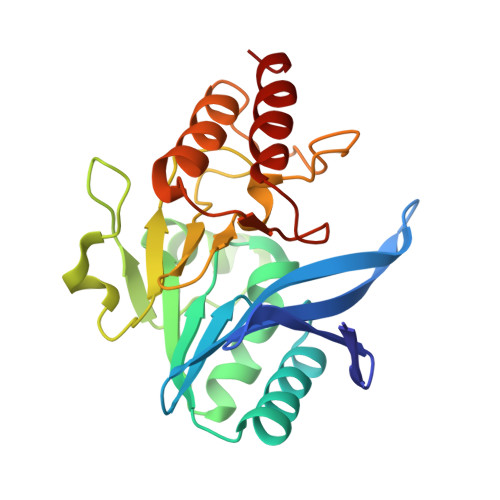Clinical Variants of New Delhi Metallo-beta-Lactamase Are Evolving To Overcome Zinc Scarcity.
Stewart, A.C., Bethel, C.R., VanPelt, J., Bergstrom, A., Cheng, Z., Miller, C.G., Williams, C., Poth, R., Morris, M., Lahey, O., Nix, J.C., Tierney, D.L., Page, R.C., Crowder, M.W., Bonomo, R.A., Fast, W.(2017) ACS Infect Dis 3: 927-940
- PubMed: 28965402
- DOI: https://doi.org/10.1021/acsinfecdis.7b00128
- Primary Citation of Related Structures:
5WIG, 5WIH - PubMed Abstract:
Use and misuse of antibiotics have driven the evolution of serine ¦Â-lactamases to better recognize new generations of ¦Â-lactam drugs, but the selective pressures driving evolution of metallo-¦Â-lactamases are less clear. Here, we present evidence that New Delhi metallo-¦Â-lactamase (NDM) is evolving to overcome the selective pressure of zinc(II) scarcity. Studies of NDM-1, NDM-4 (M154L), and NDM-12 (M154L, G222D) demonstrate that the point mutant M154L, contained in 50% of clinical NDM variants, selectively enhances resistance to the penam ampicillin at low zinc(II) concentrations relevant to infection sites. Each of the clinical variants is shown to be progressively more thermostable and to bind zinc(II) more tightly than NDM-1, but a selective enhancement of penam turnover at low zinc(II) concentrations indicates that most of the improvement derives from catalysis rather than stability. X-ray crystallography of NDM-4 and NDM-12, as well as bioinorganic spectroscopy of dizinc(II), zinc(II)/cobalt(II), and dicobalt(II) metalloforms probe the mechanism of enhanced resistance and reveal perturbations of the dinuclear metal cluster that underlie improved catalysis. These studies support the proposal that zinc(II) scarcity, rather than changes in antibiotic structure, is driving the evolution of new NDM variants in clinical settings.
Organizational Affiliation:
Division of Chemical Biology and Medicinal Chemistry, College of Pharmacy, and the LaMontagne Center for Infectious Disease, University of Texas , Austin, Texas 78712, United States.















